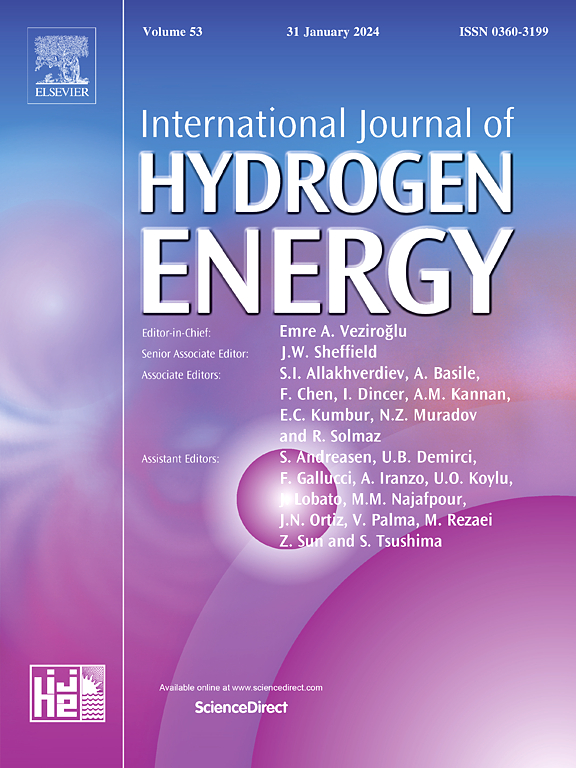Modeling microbial interactions in lactate-driven dark fermentation systems using metabolic models
IF 8.1
2区 工程技术
Q1 CHEMISTRY, PHYSICAL
引用次数: 0
Abstract
Dark fermentation (DF) is a promising alternative for biohydrogen (H2) production using agro-industrial wastes, contributing to clean energy generation and waste management. However, industrial scaling of DF is hindered by instability issues, particularly due to microbial interactions, such as competition between lactic acid bacteria (LAB) and hydrogen-producing bacteria (HPB). While LAB are often considered inhibitors of H2 production, recent studies suggest their potential role in lactate-driven DF, where HPB utilizes lactate and acetate as alternative substrates. Despite this, the mechanisms regulating LAB-HPB interactions are still a research gap. This study developed a simplified metabolic model to describe a LAB-HPB consortium performing lactate-driven DF, focusing on LAB and HPB interactions. The model was constructed based on previous models and experimental data, guided by taxonomic and functional analysis. Flux Balance Analysis (FBA) was used for model calibration. Key enzymes and electron bifurcation mechanisms involved in H2 production were identified. The model predicted that H2 production gradually declined as LAB fractions increased, with a modest reduction below 0.3 (maintaining favorable production levels) and complete inhibition occurring above 0.85. These findings highlight the importance of optimizing the HPB-to-LAB ratio and understanding their metabolic interactions to enhance H2 production. Future research should validate the model predictions and explore additional conditions to improve DF efficiency.

利用代谢模型模拟乳酸驱动暗发酵系统中的微生物相互作用
暗发酵(DF)是利用农业工业废物生产生物氢(H2)的一种有前途的替代方法,有助于清洁能源的产生和废物管理。然而,DF的工业规模化受到不稳定性问题的阻碍,特别是由于微生物相互作用,例如乳酸菌(LAB)和产氢菌(HPB)之间的竞争。虽然LAB通常被认为是H2生成的抑制剂,但最近的研究表明它们在乳酸驱动的DF中具有潜在作用,其中HPB利用乳酸和醋酸盐作为替代底物。尽管如此,调节LAB-HPB相互作用的机制仍然是一个研究空白。本研究建立了一个简化的代谢模型来描述LAB-HPB联盟进行乳酸驱动的DF,重点关注LAB和HPB的相互作用。该模型是在前人模型和实验数据的基础上,以分类学和功能分析为指导构建的。通量平衡分析(FBA)用于模型校准。确定了H2生成的关键酶和电子分岔机制。该模型预测,随着LAB分数的增加,H2产量逐渐下降,在0.3以下略有下降(保持有利的产量水平),在0.85以上发生完全抑制。这些发现强调了优化hbb - lab比例和了解它们的代谢相互作用对提高H2产量的重要性。未来的研究应该验证模型的预测,并探索提高DF效率的附加条件。
本文章由计算机程序翻译,如有差异,请以英文原文为准。
求助全文
约1分钟内获得全文
求助全文
来源期刊

International Journal of Hydrogen Energy
工程技术-环境科学
CiteScore
13.50
自引率
25.00%
发文量
3502
审稿时长
60 days
期刊介绍:
The objective of the International Journal of Hydrogen Energy is to facilitate the exchange of new ideas, technological advancements, and research findings in the field of Hydrogen Energy among scientists and engineers worldwide. This journal showcases original research, both analytical and experimental, covering various aspects of Hydrogen Energy. These include production, storage, transmission, utilization, enabling technologies, environmental impact, economic considerations, and global perspectives on hydrogen and its carriers such as NH3, CH4, alcohols, etc.
The utilization aspect encompasses various methods such as thermochemical (combustion), photochemical, electrochemical (fuel cells), and nuclear conversion of hydrogen, hydrogen isotopes, and hydrogen carriers into thermal, mechanical, and electrical energies. The applications of these energies can be found in transportation (including aerospace), industrial, commercial, and residential sectors.
 求助内容:
求助内容: 应助结果提醒方式:
应助结果提醒方式:


